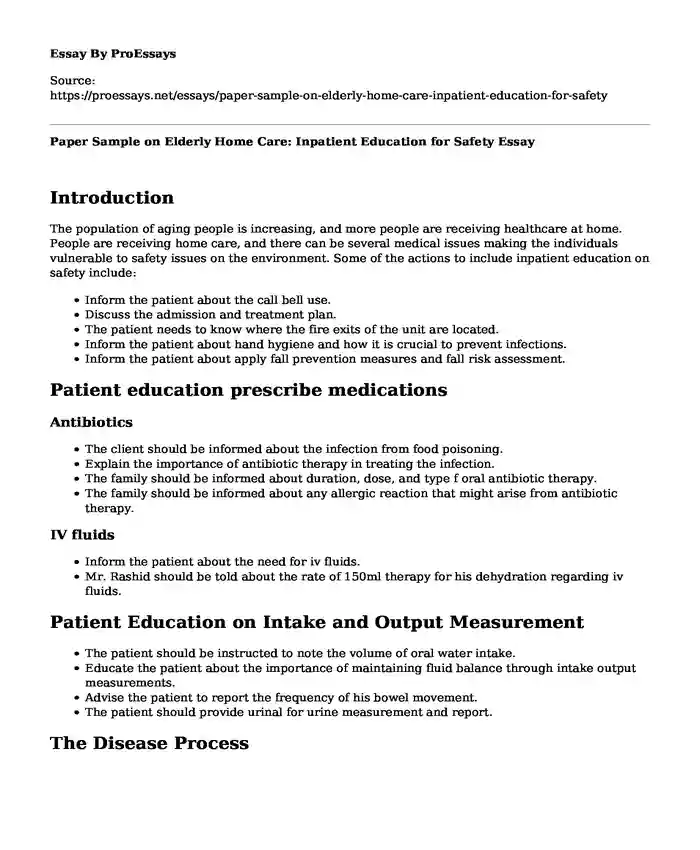Introduction
The population of aging people is increasing, and more people are receiving healthcare at home. People are receiving home care, and there can be several medical issues making the individuals vulnerable to safety issues on the environment. Some of the actions to include inpatient education on safety include:
- Inform the patient about the call bell use.
- Discuss the admission and treatment plan.
- The patient needs to know where the fire exits of the unit are located.
- Inform the patient about hand hygiene and how it is crucial to prevent infections.
- Inform the patient about apply fall prevention measures and fall risk assessment.
Patient education prescribe medications
Antibiotics
- The client should be informed about the infection from food poisoning.
- Explain the importance of antibiotic therapy in treating the infection.
- The family should be informed about duration, dose, and type f oral antibiotic therapy.
- The family should be informed about any allergic reaction that might arise from antibiotic therapy.
IV fluids
- Inform the patient about the need for iv fluids.
- Mr. Rashid should be told about the rate of 150ml therapy for his dehydration regarding iv fluids.
Patient Education on Intake and Output Measurement
- The patient should be instructed to note the volume of oral water intake.
- Educate the patient about the importance of maintaining fluid balance through intake output measurements.
- Advise the patient to report the frequency of his bowel movement.
- The patient should provide urinal for urine measurement and report.
The Disease Process
Etiology
An individual can lose too much potassium through bowel movement, sweat, or through urine. Low levels of potassium intake can result in hypokalemia. The most common ways an individual can get hypokalemia when:
- He or she vomits a lot.
- Adrenal glands and kidneys do not work well.
- He or she has diarrhea.
- Drinking a lot of alcohol.
- Taking water pills or diuretics.
- Low magnesium.
Epidemiology
Hypokalemia is mainly associated with the diagnoses of renal failure, malnutrition, cardiac disease, and shock. Additional factors for developing hypokalemia are increased blood cell production and hypothermia. There are people who are susceptible to the development of hypokalemia, and they include psychiatric patients because of drug therapy, hospitalized patients, mainly pediatric patients, and those who are critically ill.
Pathophysiologic Mechanism
Hypokalemia occurs because of transcellular shifts, decreased potassium intake, or increase potassium loss. In most cases, hypokalemia results from renal losses or gastrointestinal (GI). The renal potassium losses are associated with mainly increase mineralocorticoid-receptor. The GI losses are the leading causes of hypokalemia with chronic or severe diarrhea as the primary extrarenal cause of hypokalemia.
Common Complications That May Occur with The Alterations or Treatment Modalities
Because of low potassium levels in the body, cardiac arrhythmias manifest itself as dysfunctional heart muscles that mainly leads to ventricular and tachycardia fibrillation. Moreover, the paralysis that can be life-threatening is also a common complication for patients with hypokalemia, mainly in conditions of elevated thyroid function tests.
Patient’s Overall Prognosis
The treatment process has four main aims, which are the determination of the cause, evaluation for potential toxicities, replacement of potassium stores, and reduction of potassium losses. The standard medication is oral potassium chloride for patients with ongoing potassium loss. On the other hand, potassium-sparing diuretics are used for patients with renal functions.
Cite this page
Paper Sample on Elderly Home Care: Inpatient Education for Safety. (2023, Sep 17). Retrieved from https://proessays.net/essays/paper-sample-on-elderly-home-care-inpatient-education-for-safety
If you are the original author of this essay and no longer wish to have it published on the ProEssays website, please click below to request its removal:
- How a Nurse Leader Helps a Nurse Colleague Pursue Their Professional Goals Essay
- My Contribution to Advancing Positive Social Change through Nursing
- Research Paper on Nursing in Rural/Remote Canada: Variability, Complexity & Need for Knowledge/Skills
- Essay Sample on Organ Donation: A Battle Against Time and Shortages
- Essay Example on Mother-Child Symbiosis: Fetal Microchimerism Explained
- Essay Example on Unravelling the Difference Between HIV & AIDS
- Essay Example on Safety in Transport: Challenges & Solutions for Reducing Accident Risk







